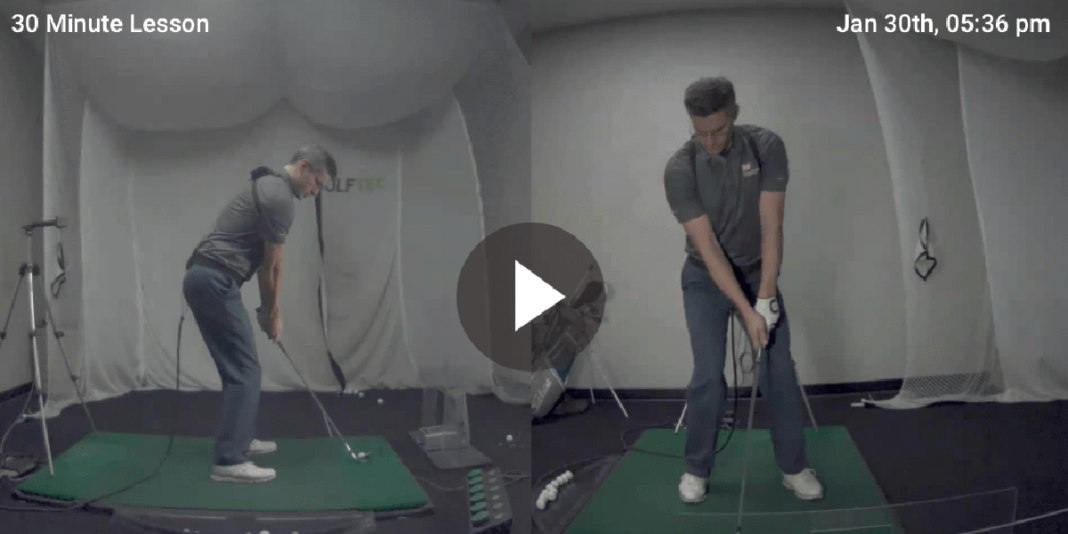A real review from a GOLFTEC Student
Sean Denning is a current Student at GOLFTEC Omaha and is the author of a blog called Par Machine. He has been playing golf for 20 years and began the 2020 season with a 3.3 handicap, and his goal is to become a scratch as he continues to work with his Coach, Jamie.
By Sean Denning
My 2019 season was a frustrating one. My handicap got as high as 4.2, and I had very little control of the golf ball. I tried making adjustments on my own to no avail. Sometimes I thought I had found a solution, only to lose it the next round. So as planned, I took five lessons from GOLFTEC in December.
This would actually be my third set of lessons from GOLFTEC. My first GOLFTEC lesson was in 2007, and what initially drew me to them was in their name – the technology. Lessons I had taken before then mostly consisted of standing on the range, hitting a few balls, listening to the instructor’s assessment, and attempting to make whatever change he suggested. But since I couldn’t see the problem I was trying to fix, making improvements was difficult.
The Technology
Using a simulator was a pretty new experience to me in 2007. I had used them when trying out new clubs at golf shops, but those machines seemed wildly inaccurate in a lot of cases. Although it seems pretty common for instructors to use simulators now, my initial lessons at GOLFTEC were my first exposure to accurate shot data. The information about my swing path, clubface angle, and shot patterns was enlightening. But that was just the beginning of the data.
GOLFTEC makes extensive use of video. Not just occasionally, but for every swing during a lesson or practice session, both face-on and down-the-line. I could see the problems with my swing, pause the video, click forward and backward frame-by-frame, and draw lines to evaluate each swing against the positions my coach was having me work on.
I could even see a side-by side comparison of my swing to a PGA tour pro when my coach wanted to better illustrate how to execute a move. Video and notes from each lesson are saved to an online account for easy review later. I still have access to records from most of my lessons, and an image from one of my 2013 videos is below.

You can see the body position sensors in that photo. It’s a pretty simple setup: straps that go around the waist and chest with a monitor on a tripod. But I had no idea what the numbers for hip sway, shoulder tilt, hip turn, shoulder tilt, and shoulder bend were about. My coach told me how my positions compared to better amateur and professional golfers and used them to help decide what I needed to work on.
GOLFTEC has even more of this data now. Here’s what their website has to say about their motion study and how they use it:
“We sampled 48 different body motions from over 13,000 golfers of all abilities to create the GOLFTEC SwingTRU Motion Study. Through our findings we have identified key body positions within the swing that directly correlate to a player’s handicap – conclusive evidence providing further insight into the golf swing and a golfer’s most efficient methods to improve.”
This technology made GOLFTEC different from lessons I had taken in the past, and it produced results for me where the other lessons had fallen short.
My Initial Results
I wasn’t tracking my handicap before my GOLFTEC lessons in 2007, but it was probably around 5. After those lessons, I had the best summer of golf that I can remember playing up to that point. I was regularly shooting in the mid-70s and even posted a 71 on a course with a 71.2/123 rating. I also started keeping a handicap, which got down to 3.
Unfortunately, despite my progress, I didn’t play much from 2008-2012. I kept busy with my engineering studies and student organizations, working part-time during school, then transitioning to a full-time career, getting married, etc. But when I decided I wanted to get back into golf, I knew exactly how to get my game in shape: GOLFTEC.
I had two pretty ambitious goals when I took my second set of lessons from GOLFTEC in 2013: I wanted to be a scratch golfer, and I wanted to play well in competitions.
After spending the 2013-2014 off-season working on my swing, I started playing in competitions in 2014. As the swing changes started taking effect, my handicap began dropping slowly. But the difference in my tournament performance was much more dramatic.
Before, I could play well during casual rounds, but my scores skyrocketed under pressure. This problem was particularly frustrating when I played high school golf. I posted good scores in practice, but my tournament scores were almost always disappointing.
After the GOLFTEC lessons, I was still as nervous as ever playing in tournaments, but somehow my swing seemed to hold up better. I could actually play to my handicap in competition! In fact, some of my best rounds in 2014-2017 came during tournaments. This experience was totally new to me. I didn’t understand until after I had improved that although my previous swing flaws were manageable during casual play, my swing would break down under pressure.
My handicap didn’t make it down to scratch though. It almost got there in 2016 when it hit a low of 0.3, but then it bounced up again and has hung around 3 since 2017.

Light Bulb!
So I’m back for another attempt at my goal of playing scratch golf. And my first lesson back at GOLFTEC in December of 2019 was as eye-opening as ever. I came into the lesson frustrated with my game and completely baffled about what was causing my scores to rise.
It only took my coach a couple of minutes to diagnose the main issue. I probably spent more than a whole season trying to figure it out myself, and just like that, I had an answer (which is not to say that I was instantly able to implement the solution, but at least I knew what it was). I should have gone in sooner.









